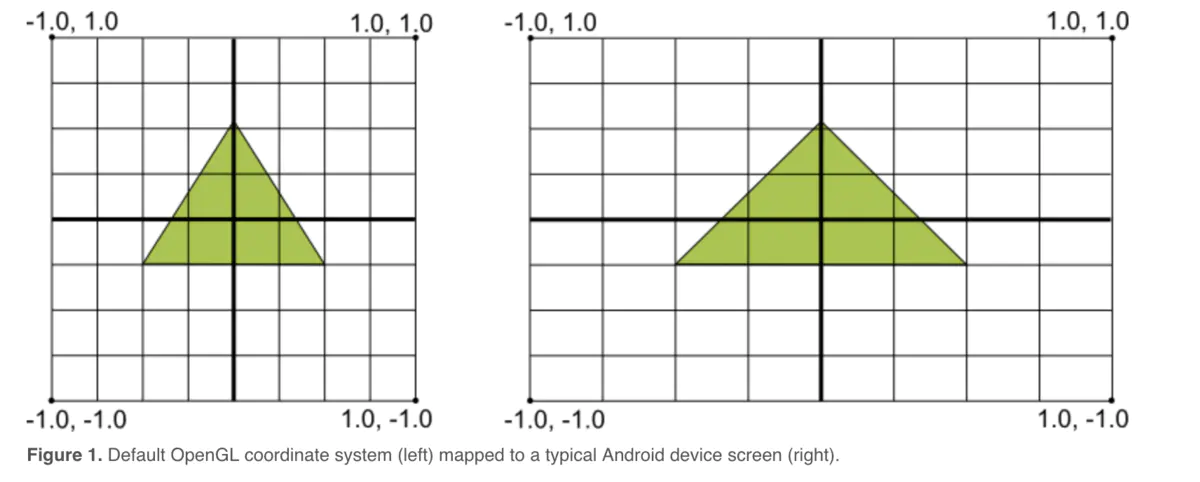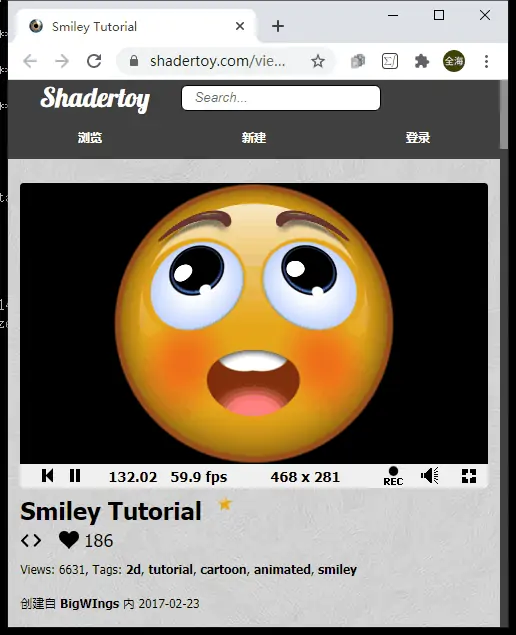图形学笔记 --《The Book of Shaders》读书笔记
The Book of Shaders – 这是一本非常坑爹的书,因为作者没写完。
可编程渲染管线 OpenGL Shader / GLSL
编辑器:https://thebookofshaders.com/edit.php
Firefox 着色编辑器:https://developer.mozilla.org/zh-CN/docs/Tools/Shader_Editor
TOOLS
-
ShaderToy.com Shader
-
glslViewer
GlslViewer is a flexible console-base OpenGL Sandbox to display 2D/3D GLSL shaders without the need of an UI.
-
glslCanvas
用 WebGL 显示 shader。Simple tool to load GLSL shaders on HTML Canvas using WebGL.
-
GraphToy
在 WebGL 中可视化 GLSL 函数。
http://www.iquilezles.org/apps/graphtoy/
Shadershop:视觉化和直观的方式教你如何建造复杂的函数。http://tobyschachman.com/Shadershop/
-
Three.js
无数程序示例,教程,书籍,教你如何用这个 JavaScript 库做出酷炫的 3D 图像。
-
Processing
Processing is a flexible software sketchbook and a language for learning how to code within the context of the visual arts. 更多 Processing 的 shader 教程戳 tutorial。
-
openFrameworks
开源的、跨平台的 C++ 工具包,它的设计目的为开发创造过程提供一个更加简单和直观的框架。 Introducing Shaders
抽象性、盲视、无记忆
为了能使许多管线并行运行,每一个线程必须与其他的相独立。 我们称这些线程对于其他线程在进行的运算是“盲视”的。 这个限制就会使得所有数据必须以相同的方向流动。 所以就不可能检查其他线程的输出结果,修改输入的数据,或者把一个线程的输出结果输入给另一个线程。 如果允许线程到线程的数据流动将使所有的数据面临威胁。
并且 GPU 会让所有并行的微处理器(管道们)一直处在忙碌状态;只要它们一有空闲就会接到新的信息。 一个线程不可能知道它前一刻在做什么。 它可能是在画操作系统界面上的一个按钮,然后渲染了游戏中的一部分天空,然后显示了一封 email 中的一些文字。 每个线程不仅是“盲视”的,而且还是“无记忆”的。 同时,它要求编写一个通用的规则,依据像素的不同位置依次输出不同的结果。
着色器输入
uniform vec3 iResolution; // viewport resolution (in pixels)
uniform float iTime; // shader playback time (in seconds)
uniform float iTimeDelta; // render time (in seconds)
uniform int iFrame; // shader playback frame
uniform float iChannelTime[4]; // channel playback time (in seconds)
uniform vec3 iChannelResolution[4]; // channel resolution (in pixels)
uniform vec4 iMouse; // mouse pixel coords. xy: current (if MLB down), zw: click
uniform samplerCube iChannel0..3; // input channel Cube
uniform sampler2D iChannel0..3; // input channel 2D
uniform vec4 iDate; // (year, month, day, time in seconds)
uniform float iSampleRate; // sound sample rate (i.e., 44100)
Hello World
#ifdef GL_ES
precision mediump float; // 中等精度
#endif
uniform float u_time; // 统一值,时间(加载后的秒数)iTime
uniform vec2 u_resolution; // 画布尺寸(宽,高)iResolution
uniform vec2 u_mouse; // 鼠标位置(在屏幕上哪个像素)iMouse xy:当前位置, zw:点击位置
void main() {
gl_FragColor = vec4(abs(sin(u_time)),0.0,1.0,1.0); // 红绿蓝和透明度通道
}
GLSL 语言规范并不保证变量会被自动转换类别。 要求有最精简的语言规范。因而,自动强制类型转换并没有包括在其中。 最好养成在 float 型数值里加一个 . 的好习惯。
Uniforms
每个线程和其他线程之间不能有数据交换,但我们能从 CPU 给每个线程输入数据。 因为显卡的架构,所有线程的输入值必须统一(uniform),而且必须设为只读。 也就是说,每条线程接收相同的数据,并且是不可改变的数据。
gl_FragCoord
varying(变化值)。gl_FragCoord 存储了活动线程正在处理的像素或屏幕碎片的坐标。 因为每个像素的坐标都不同,所以我们把它叫做 varying(变化值)。
#ifdef GL_ES
precision mediump float;
#endif
uniform vec2 u_resolution;
uniform vec2 u_mouse;
uniform float u_time;
void main() {
vec2 st = gl_FragCoord.xy/u_resolution;
gl_FragColor = vec4(st.x,st.y,0.0,1.0);
}

算法绘画 造型函数
y = mod(x,0.5); // 返回 x 对 0.5 取模的值
//y = fract(x); // 仅仅返回数的小数部分
//y = ceil(x); // 向正无穷取整
//y = floor(x); // 向负无穷取整
//y = sign(x); // 提取 x 的正负号
//y = abs(x); // 返回 x 的绝对值
//y = clamp(x,0.0,1.0); // 把 x 的值限制在 0.0 到 1.0
//y = min(0.0,x); // 返回 x 和 0.0 中的较小值
//y = max(0.0,x); // 返回 x 和 0.0 中的较大值
颜色
下面的代码展示了所有访问相同数据的方式:
vec4 vector;
vector[0] = vector.r = vector.x = vector.s;
vector[1] = vector.g = vector.y = vector.t;
vector[2] = vector.b = vector.z = vector.p;
vector[3] = vector.a = vector.w = vector.q;
HSB
#ifdef GL_ES
precision mediump float;
#endif
#define TWO_PI 6.28318530718
uniform vec2 u_resolution;
uniform float u_time;
// Function from Iñigo Quiles
// https://www.shadertoy.com/view/MsS3Wc
vec3 hsb2rgb( in vec3 c ){
vec3 rgb = clamp(abs(mod(c.x*6.0+vec3(0.0,4.0,2.0),
6.0)-3.0)-1.0,
0.0,
1.0 );
rgb = rgb*rgb*(3.0-2.0*rgb);
return c.z * mix( vec3(1.0), rgb, c.y);
}
void main(){
vec2 st = gl_FragCoord.xy/u_resolution;
vec3 color = vec3(0.0);
// Use polar coordinates instead of cartesian
vec2 toCenter = vec2(0.5)-st;
float angle = atan(toCenter.y,toCenter.x);
float radius = length(toCenter)*2.0;
// Map the angle (-PI to PI) to the Hue (from 0 to 1)
// and the Saturation to the radius
color = hsb2rgb(vec3((angle/TWO_PI)+0.5,radius,1.0));
gl_FragColor = vec4(color,1.0);
}
形状
叉乘 $a \times b$
也叫向量积。结果是一个和已有两个向量都垂直的向量,向量模长是向量 A,B 组成平行四边形的面积;向量方向是垂直于向量 A,B 组成的平面。
点乘 $a \cdot b$
也叫数量积。几何意义:投影。结果是一个向量在另一个向量方向上投影的长度,是一个标量。
$\mathbf{A} \cdot \mathbf{B}=|\mathbf{A} || \mathbf{B}| \cos \theta$
#ifdef GL_ES
precision mediump float;
#endif
#define PI 3.14159265359
#define TWO_PI 6.28318530718
uniform vec2 u_resolution;
uniform vec2 u_mouse;
uniform float u_time;
void main() {
vec2 st = gl_FragCoord.xy / u_resolution.xy;
st.x *= u_resolution.x / u_resolution.y;
vec3 color = vec3(0.0);
float d = 0.0;
st = st *2.-1.;
int N = 5; // Number of sides of your shape
float a = atan(st.x,st.y)+PI;
float r = TWO_PI/float(N);
d = cos(floor(.5+a/r)*r-a)*length(st);
color = vec3(1.0-smoothstep(.4,.41,d));
gl_FragColor = vec4(color,1.0);
}
做一个 shader 来表现流体的质感
// Author @patriciogv - 2015
// http://patriciogonzalezvivo.com
#ifdef GL_ES
precision mediump float;
#endif
uniform vec2 u_resolution;
uniform vec2 u_mouse;
uniform float u_time;
vec3 mod289(vec3 x) { return x - floor(x * (1.0 / 289.0)) * 289.0; }
vec2 mod289(vec2 x) { return x - floor(x * (1.0 / 289.0)) * 289.0; }
vec3 permute(vec3 x) { return mod289(((x*34.0)+1.0)*x); }
float snoise(vec2 v) {
const vec4 C = vec4(0.211324865405187, // (3.0-sqrt(3.0))/6.0
0.366025403784439, // 0.5*(sqrt(3.0)-1.0)
-0.577350269189626, // -1.0 + 2.0 * C.x
0.024390243902439); // 1.0 / 41.0
vec2 i = floor(v + dot(v, C.yy) );
vec2 x0 = v - i + dot(i, C.xx);
vec2 i1;
i1 = (x0.x > x0.y) ? vec2(1.0, 0.0) : vec2(0.0, 1.0);
vec4 x12 = x0.xyxy + C.xxzz;
x12.xy -= i1;
i = mod289(i); // Avoid truncation effects in permutation
vec3 p = permute( permute( i.y + vec3(0.0, i1.y, 1.0 ))
+ i.x + vec3(0.0, i1.x, 1.0 ));
vec3 m = max(0.5 - vec3(dot(x0,x0), dot(x12.xy,x12.xy), dot(x12.zw,x12.zw)), 0.0);
m = m*m ;
m = m*m ;
vec3 x = 2.0 * fract(p * C.www) - 1.0;
vec3 h = abs(x) - 0.5;
vec3 ox = floor(x + 0.5);
vec3 a0 = x - ox;
m *= 1.79284291400159 - 0.85373472095314 * ( a0*a0 + h*h );
vec3 g;
g.x = a0.x * x0.x + h.x * x0.y;
g.yz = a0.yz * x12.xz + h.yz * x12.yw;
return 130.0 * dot(m, g);
}
void main() {
vec2 st = gl_FragCoord.xy/u_resolution.xy;
st.x *= u_resolution.x/u_resolution.y;
vec3 color = vec3(0.0);
vec2 pos = vec2(st*3.);
float DF = 0.0;
// Add a random position
float a = 0.0;
vec2 vel = vec2(u_time*.1);
DF += snoise(pos+vel)*.25+.25;
// Add a random position
a = snoise(pos*vec2(cos(u_time*0.15),sin(u_time*0.1))*0.1)*3.1415;
vel = vec2(cos(a),sin(a));
DF += snoise(pos+vel)*.25+.25;
color = vec3( smoothstep(.7,.75,fract(DF)) );
gl_FragColor = vec4(1.0-color,1.0);
}
Smiley Tutorial
https://www.shadertoy.com/view/lsXcWn

理论:https://zhuanlan.zhihu.com/p/274849965
The Book of Shaders
TODO: https://thebookofshaders.com/13/?lan=ch – 后面的看不了了?喔靠。
https://github.com/patriciogonzalezvivo/thebookofshaders
Step-by-step guide through the abstract and complex universe of Fragment Shaders.
Shader School 有点老旧了
https://github.com/stackgl/shader-school
A workshopper for GLSL shaders and graphics programming
Other
-
GlslViewer is a flexible console-base OpenGL Sandbox to display 2D/3D GLSL shaders without the need of an UI.
You can definitely make your own UI or wrapper using the Python Module (include) or any other tool that communicates back/forth with glslViewer thought the standard POSIX console In/Out or OSC.
GlslViewer support both 2D shaders and/or 3D shaders when a geometry (LST, PLY, OBJ or GLTF) is provided.
-
A Processing/Java library for high performance GPU-Computing (GLSL).
https://github.com/diwi/PixelFlow
Fluid Simulation + SoftBody Dynamics + Optical Flow + Rendering + Image Processing + Particle Systems + Physics + …
参考资料快照
- https://thebookofshaders.com/edit.php
- https://developer.mozilla.org/zh-CN/docs/Tools/Shader_Editor
- https://www.shadertoy.com/
- https://github.com/patriciogonzalezvivo/glslViewer
- https://github.com/patriciogonzalezvivo/glslCanvas
- http://www.iquilezles.org/apps/graphtoy/
- http://tobyschachman.com/Shadershop/
- http://threejs.org/
- https://processing.org/tutorials/pshader/
- https://processing.org/
- https://openframeworks.cc/ofBook/chapters/shaders.html
- http://openframeworks.cc/
- https://www.jianshu.com/p/64c236d5c67a
- https://www.shadertoy.com/view/MsS3Wc
- http://patriciogonzalezvivo.com
- https://www.shadertoy.com/view/lsXcWn
- https://zhuanlan.zhihu.com/p/274849965
- https://thebookofshaders.com/13/?lan=ch
- https://github.com/patriciogonzalezvivo/thebookofshaders
- https://thebookofshaders.com/?lan=ch
- https://github.com/stackgl/shader-school
- https://github.com/McNopper/OpenGL
- http://nopper.tv
- http://patriciogonzalezvivo.com/2015/glslViewer/
- https://github.com/diwi/PixelFlow
- https://diwi.github.io/PixelFlow/

 .
.